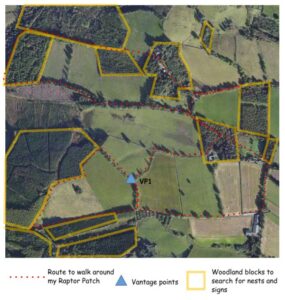The breeding season for the majority of raptor species runs from February to the end of August. When the breeding season comes along you will be spending time out in your Raptor Patch looking out for flying and perched raptors (particularly in the early part of the breeding season when territorial birds will be displaying), identifying active nests and also looking for other field signs such as pellets and prey remains. It is therefore worth investing time during the non-breeding season to get to grips with your Raptor Patch, both remotely and on the ground, and planning ahead for the forthcoming breeding season.
Desk study of my Raptor Patch
 This may well sound extremely boring especially when you just want to be getting out there and cracking on with monitoring – but trust me – this is time well spent.
This may well sound extremely boring especially when you just want to be getting out there and cracking on with monitoring – but trust me – this is time well spent.
Spend a little bit of time studying a 1:25000 Ordnance Survey map of your Raptor Patch and also some aerial photography or satellite imagery. You may wish to explore the following online resources to assist you with this:
Grab a grid reference: http://www.bnhs.co.uk/focuson/grabagridref/html
Bing maps: https://www.bing.com/mapspreview
Where’s the path: http://wtp2.appspot.com/wheresthepath.htm
This will allow you to:
- consider access routes in and around your Raptor Patch.
- identify potentially suitable vantage points (VPs) from which you could watch for signs of raptor activity in different parts of your Raptor Patch.
- get a feel for the extent of broad habitat types that your Raptor Patch contains and, therefore, which of the widespread raptor species – Buzzard, Kestrel, Sparrowhawk and Raven – your patch has the potential to support.
Even if you think you already know your Raptor Patch fairly well, there may be some areas within in it that you are not familiar with, and which you should be careful not to neglect.
Exploring my Raptor Patch on foot
Having sussed out the terrain, potential routes and vantage points from the comfort of your chair, spend some time recce-ing your Raptor Patch on foot. You should vary your route around your Raptor Patch to ensure that you explore it all – follow your nose! It may help to draw lines delimiting your view from particular vantage points on a map to see whether there are gaps in coverage, and to identify how best these might be filled in. Move, add to or remove vantage points to ensure efficient cover of your whole Raptor Patch.
The non-breeding season does not have to be a complete non-event in terms of doing some valuable field work either, and in fact there are a number of activities you can do that will put you in good stead for the coming breeding season. These include looking out for Buzzard and Raven (both these species occupy their home range all year) and identifying and mapping potential nest sites where Kestrels might breed, clusters of old Sparrowhawk nests and large nests in deciduous woodland.
